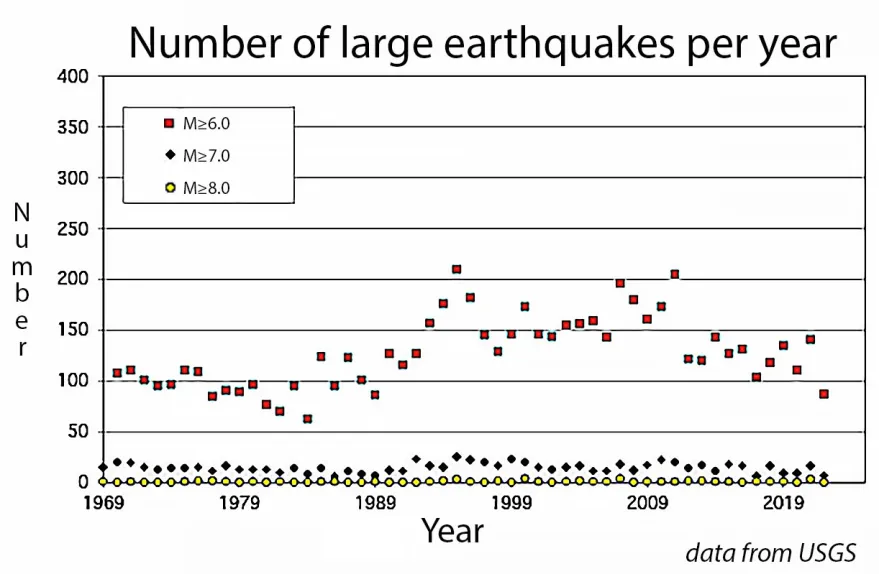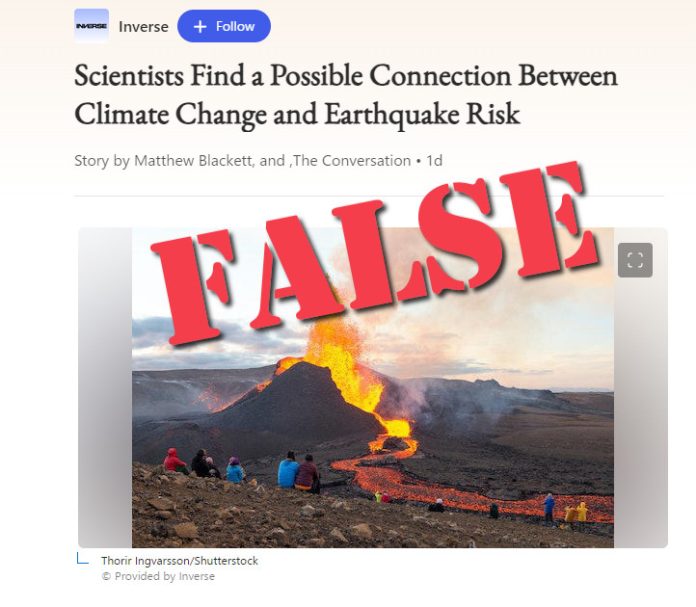A story posted in The Conversation, and distributed by MSN News, claims that climate change is influencing the number of earthquakes. Data shows this is false. The study was so limited in scope it isn’t representative of climate change either by reach or time.
The article, “Scientists Find a Possible Connection Between Climate Change and Earthquake Risk” claims that seasonal monsoons from India, which produce snow and ice in the Himalayan Mountain range, set the stage for Earthquakes when the water drains, and the ice melts – which relieves surface pressure from the weight of the ice.
While loss of ice and water weight may in fact result in some small tremors as water evaporates and ice melts, causing a rebound of the land due to the removed weight, the article is severely flawed in trying to link these events to climate change to them for several reasons.
First, this study covers just a small region of the Earth. Climate change is a global phenomenon.
Second, the time-period involved in the study, 17 years, isn’t long enough to establish any sort of a climate connection whatsoever, because the minimum time required to establish a climate period is 30 years, according to the World Meteorological Organization:
Climate, sometimes understood as the “average weather,” is defined as the measurement of the mean and variability of relevant quantities of certain variables (such as temperature, precipitation or wind) over a period of time, ranging from months to thousands or millions of years. The classical period is 30 years, as defined by the World Meteorological Organization (WMO). Climate in a wider sense is the state, including a statistical description, of the climate system.
The monsoon has impacted moisture in Himalayan mountains for time immemorial. Monsoon patterns have not changed appreciably over the past 17 years. So there is no reason why a seasonal weather pattern, that has occurred across millennia, would suddenly start causing earthquakes.
Third, monsoonal moisture is a weather event, not a climate event, spanning weeks to months instead of the decades that climate change is observed over.
Fourth, and most important, looking at major earthquake data, with values over 7.5 on the Richter Scale (the ones that do the worst damage) on a global scale yields a downward trend as seen in Figure 1 below from Roger Pielke, Jr. PhD. The figure shows data from the U.S. Geological Survey for all earthquakes of magnitude 7.5 or greater since 2000. Over that period there was a decrease in these major earthquakes. Four of the past 6 years saw 4 or less magnitude 7.5 or greater earthquakes, while the previous 17 years before that only saw 3 such years. Of course, impacts depend not just on how strong it is, but also where the earthquakes occur and the infrastructure of that region.

That data set doesn’t cover 30 years, but it does cover a time period 5 years longer than the study cited by MSN/The Conversation. To get a true climate change comparison, 50 years of global data will do.
An article in the Times-Standard asks: Are there more earthquakes now than 50 years ago?
Global seismic detection has improved in the past 50 years and so we see more smaller quakes in the catalog. But the network in the ’60s was good enough to record the bigger quakes and restricting the analysis to M6 and larger is a better way to approach the increase question. There is variability but no trend.
The becomes clear when you look at Figure 2 below.

Indeed, the global authority on earthquakes, the U.S. Geological Survey (USGS), answered the question with data all the way back to 1900, saying:
A temporary increase or decrease in seismicity is part of the normal fluctuation of earthquake rates. Neither an increase nor decrease worldwide is a positive indication that a large earthquake is imminent.
The ComCat earthquake catalog contains an increasing number of earthquakes in recent years–not because there are more earthquakes, but because there are more seismic instruments and they are able to record more earthquakes.
Just like with weather events that are now immediately reported to news media via cellphones, due to improved and widespread technology, we can now see more earthquakes than ever before. As USGS said, that doesn’t mean they are increasing due to any factors, be it the state of our naturally restless Earth, which has about 55 per day, or 20,000 earthquakes per year or so-called climate change effects.
Focusing on a small region of the world, for just a few years, as this study did, is insufficient to make valid long-term claims about the impact of global climate change on earthquakes or any other phenomenon. This study and the media coverage of it is more proof of the willingness of climate alarmists to link every phenomenon to climate change, no matter how absurd the connection.
More rain, climate change. Less rain, climate change. Stronger monsoons, climate change, weaker monsoons, climate change. Climate change causes crime, mental illness and substance abuse, sports injuries, and now earthquakes. As Climate Depot decried in June, Climate Change causes everything.
This study, like others linking climate change to non-climactic events with no direct connection to weather or temperatures over time is just one more junk climate science claim that would be laughable, if so many people weren’t being led to believe its false claims and call for action restricting fundamental freedoms. The Conversation and MSN are collaborators in an anti-science, anti-progress, and anti-human agenda.
















